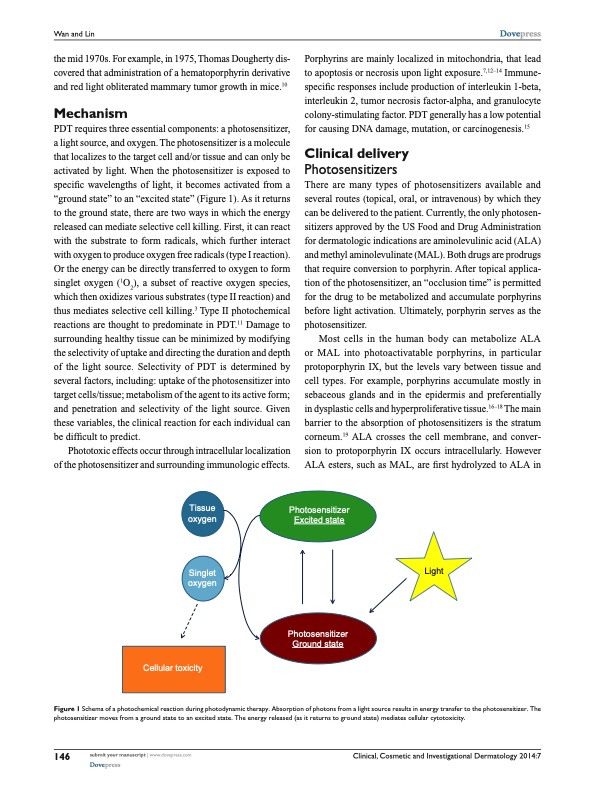
PDF Publication Title:
Text from PDF Page: 003
wan and Lin Dovepress the mid 1970s. For example, in 1975, Thomas Dougherty dis- covered that administration of a hematoporphyrin derivative and red light obliterated mammary tumor growth in mice.10 Mechanism PDT requires three essential components: a photosensitizer, a light source, and oxygen. The photosensitizer is a molecule that localizes to the target cell and/or tissue and can only be activated by light. When the photosensitizer is exposed to specific wavelengths of light, it becomes activated from a “ground state” to an “excited state” (Figure 1). As it returns to the ground state, there are two ways in which the energy released can mediate selective cell killing. First, it can react with the substrate to form radicals, which further interact with oxygen to produce oxygen free radicals (type I reaction). Or the energy can be directly transferred to oxygen to form singlet oxygen (1O ), a subset of reactive oxygen species, thus mediates selective cell killing.3 Type II photochemical reactions are thought to predominate in PDT.11 Damage to surrounding healthy tissue can be minimized by modifying the selectivity of uptake and directing the duration and depth of the light source. Selectivity of PDT is determined by several factors, including: uptake of the photosensitizer into target cells/tissue; metabolism of the agent to its active form; and penetration and selectivity of the light source. Given these variables, the clinical reaction for each individual can be difficult to predict. Phototoxic effects occur through intracellular localization of the photosensitizer and surrounding immunologic effects. Porphyrins are mainly localized in mitochondria, that lead to apoptosis or necrosis upon light exposure.7,12–14 Immune- specific responses include production of interleukin 1-beta, interleukin 2, tumor necrosis factor-alpha, and granulocyte colony-stimulating factor. PDT generally has a low potential for causing DNA damage, mutation, or carcinogenesis.15 Clinical delivery Photosensitizers There are many types of photosensitizers available and several routes (topical, oral, or intravenous) by which they can be delivered to the patient. Currently, the only photosen- sitizers approved by the US Food and Drug Administration for dermatologic indications are aminolevulinic acid (ALA) and methyl aminolevulinate (MAL). Both drugs are prodrugs that require conversion to porphyrin. After topical applica- tion of the photosensitizer, an “occlusion time” is permitted for the drug to be metabolized and accumulate porphyrins before light activation. Ultimately, porphyrin serves as the photosensitizer. Most cells in the human body can metabolize ALA or MAL into photoactivatable porphyrins, in particular protoporphyrin IX, but the levels vary between tissue and cell types. For example, porphyrins accumulate mostly in sebaceous glands and in the epidermis and preferentially in dysplastic cells and hyperproliferative tissue.16–18 The main barrier to the absorption of photosensitizers is the stratum corneum.19 ALA crosses the cell membrane, and conver- sion to protoporphyrin IX occurs intracellularly. However ALA esters, such as MAL, are first hydrolyzed to ALA in 2 which then oxidizes various substrates (type II reaction) and Tissue oxygen Singlet oxygen Photosensitizer Excited state Photosensitizer Ground state Light Figure 1 Schema of a photochemical reaction during photodynamic therapy. Absorption of photons from a light source results in energy transfer to the photosensitizer. The photosensitizer moves from a ground state to an excited state. The energy released (as it returns to ground state) mediates cellular cytotoxicity. 146 submit your manuscript | www.dovepress.com Dovepress Clinical, Cosmetic and Investigational Dermatology 2014:7 Cellular toxicityPDF Image | applications of photodynamic therapy dermatology

PDF Search Title:
applications of photodynamic therapy dermatologyOriginal File Name Searched:
photodynamic-therapy-dermatology.pdfDIY PDF Search: Google It | Yahoo | Bing
Cruise Ship Reviews | Luxury Resort | Jet | Yacht | and Travel Tech More Info
Cruising Review Topics and Articles More Info
Software based on Filemaker for the travel industry More Info
The Burgenstock Resort: Reviews on CruisingReview website... More Info
Resort Reviews: World Class resorts... More Info
The Riffelalp Resort: Reviews on CruisingReview website... More Info
| CONTACT TEL: 608-238-6001 Email: greg@cruisingreview.com | RSS | AMP |